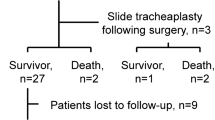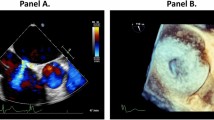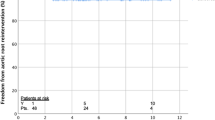Abstract
Atrial-level repair for transposition of the great arteries is one of the greatest achievements of modern cardiovascular medicine, transforming a once fatal congenital heart condition into one with excellent long-term survival. Although atrial-level repair has been supplanted by the arterial switch, there remains a population of patients who underwent atrial-level repair as children and now require ongoing care as adults. Survival slowly continues to decline in this population mainly owing to systemic right ventricular dysfunction and sudden death. Other problems include sinus node dysfunction, atrial arrhythmias, systemic atrioventricular valve regurgitation, baffle problems, and pulmonary hypertension. Evaluation and management of these late complications is addressed.
Key Points
-
Patients who have undergone atrial-level repair for transposition of the great arteries comprise an important group of adults with congenital heart disease
-
Although most adult patients with atrial-level repair continue to do well clinically, there remains a steady attrition, mainly owing to sudden arrhythmic death and systemic ventricular dysfunction
-
Late morbidity includes sinus node dysfunction, atrial flutter, systemic ventricular dysfunction, systemic atrioventricular valve regurgitation, and stenosis of the superior vena caval baffle
-
Interventional therapy is available for sinus node dysfunction, atrial flutter, baffle stenoses and other anatomic problems; a thorough understanding of the cardiac anatomy is required for successful application of these techniques
-
Interval follow-up is required in all patients and systemic ventricular function should be followed
-
At this time, data do not indicate that decline in ventricular function can be prevented by medical therapy
-
Pregnancy and childbirth is possible for women with this anatomy albeit at some increased risk of worsening ventricular dysfunction and systemic atrioventricular valve regurgitation
This is a preview of subscription content, access via your institution
Access options
Subscribe to this journal
Receive 12 print issues and online access
$209.00 per year
only $17.42 per issue
Buy this article
- Purchase on Springer Link
- Instant access to full article PDF
Prices may be subject to local taxes which are calculated during checkout








Similar content being viewed by others
References
Fyler DC (1980) Report of the New England regional infant cardiac program. Pediatrics 65 (Suppl): 376–461
Liebman J et al. (1969) Natural history of transposition of the great arteries: anatomy and birth and death characteristics. Circulation 40: 237–262
Paul MH et al. (1992) Congenital heart disease after pediatrics: a quantitative model of the challenge—patients and providers [abstract]. J Am Coll Cardiol 19: 355A
Senning A (1959) Surgical correction of transposition of the great vessels. Surgery 45: 966–980
Mustard WT (1964) Successful two-stage correction of the transposition of the great vessels. Surgery 55: 469–472
Mustard WT et al. (1964) The surgical management of transposition of great arteries. J Thorac Cardiovasc Surg 48: 953–958
Rashkind WJ and Miller WW (1966) Creation of an atrial septal defect without thoracotomy: a palliative approach to complete transposition of the great arteries. JAMA 196: 991–992
Quaegebeur JM et al. (1977) Revival of the Senning operation in the treatment of transposition of the great arteries. Thorax 32: 517–524
Wells WJ and Blackstone EH (2000) Intermediate outcome after Mustard and Senning procedures: a study by the Congenital Heart Surgeons Society. Semin Thorac Cardiovasc Surg Pediatr Card Surg Annu 3: 186–197
Jatene AD et al. (1982) Anatomic correction of transposition of the great arteries. J Thorac Cardiovasc Surg 83: 20–26
Williams WG et al.; members of the Congenital Heart Surgeons Society (2003) Outcomes of 829 neonates with complete transposition of the great arteries 12–17 years after repair. Eur J Cardiothorac Surg 24: 1–10
Castaneda AR et al. (1988) The early results of treatment of simple transposition in the current era. J Thorac Cardiovasc Surg 95: 14–28
Birnie D et al. (1998) Outcomes of transposition of the great arteries in the era of atrial inflow correction. Heart 80: 170–173
Moons P et al. (2004) Long term outcome up to 30 years after the Mustard or Senning operation: a nationwide multicenter study in Belgium. Heart 90: 307–313
Wilson NJ et al. (1998) Long-term outcome after the Mustard Repair for simple transposition of the great arteries: 28-year follow-up. J Am Coll Cardio 32: 758–765
Deanfield J et al. (1988) Arrhythmia and late mortality after Mustard and Senning operation for transposition of the great arteries: an eight year prospective study. J Thorac Cardiovasc Surg 96: 569–576
Gewillig M et al. (1991) Risk factors for arrhythmia and death after Mustard operation for simple transposition of the great arteries. Circulation 84 (Suppl III): 187–192
Gatzoulis MA et al. (2000) Late arrhythmia in adults with the mustard procedure for transposition of great arteries: a surrogate marker for right ventricular dysfunction? Heart 84: 409–415
Puley G et al. (1999) Arrhythmia and survival in patients >18 years of age after the Mustard procedure for complete transposition of the great arteries. Am J Cardiol 83: 1080–1084
Triedman JK (2002) Arrhythmias in adults with congenital heart disease. Heart 87: 383–389
Kammeraad JA et al. (2004) Predictors of sudden cardiac death after Mustard or Senning repair for transposition of the great arteries. J Am Coll Cardiol 44: 1095–1102
Janousek J et al. (1994) Atrial baffle procedures for complete transposition of the great arteries; natural course of sinus node dysfunction and risk factors for dysrhythmias and sudden death. Z Kardiol 83: 933–938
Ebenroth ES et al. (2000) Late onset of pulmonary hypertension after successful Mustard surgery for d-transposition of the great arteries. Am J Cardiol 85: 127–130
Sun ZH et al. (2004) Increased QT dispersion and loss of sinus rhythm as risk factors for late sudden death after Mustard or Senning procedures for transposition of the great arteries. Am J Cardiol 94: 138–141
Hornung TS et al. (2002) Excessive right ventricular hypertrophic response in adults with the mustard procedure for transposition of the great arteries. Am J Cardiol 90: 800–803
Millane T et al. (2000) Role of ischemia and infarction in late right ventricular dysfunction after atrial repair of transposition of the great arteries. J Am Coll Cardiol 35: 1661–1668
Wong KY et al. (1988) Longitudinal study of ventricular function after the Mustard operation for transposition of the great arteries: a long term follow up. Br Heart J 60: 316–323
Roos-Hesselink JW et al. (2004) Decline in ventricular function and clinical condition after Mustard repair for transposition of the great arteries (a prospective study of 22–29 years). Eur Heart J 14: 1863–1864
VanSon JA et al. (1996) Regression of tricuspid regurgitation after two-stage arterial switch operation for failing systemic ventricle after atrial inversion operation. J Thorac Cardiovasc Surg 111: 342–347
Theissen P et al. (1991) Magnetic resonance imaging of cardiac function and morphology in patients with transposition of the great arteries following Mustard procedure. Thorac Cardiovasc Surg 39 (Suppl 3): 221–224
Schmid FX et al. (1995) Left ventricular outflow tract obstruction in TGA: treatment with LV-to-PA valved conduit. Ann Thorac Surg 59: 201–204
Bowyer JJ et al. (1990) Exercise ability after Mustard's operation. Arch Dis Child 65: 865–870
Newfeld EA et al. (1974) Pulmonary vascular disease in complete transposition of the great arteries: a study of 200 patients. Am J Cardiol 34: 75–78
Rivenes SM et al. (1998) Development of advanced pulmonary vascular disease in d-transposition of the great arteries after the neonatal arterial switch operation. Tex Heart Inst J 25: 201–215
Dajani AS et al. (1997) Prevention of bacterial endocarditis. Recommendations by the American Heart Association. JAMA 277: 1794–1801
Wilson W et al.; American Heart Association Rheumatic Fever, Endocarditis, and Kawasaki Disease Committee; American Heart Association Council on Cardiovascular Disease in the Young; American Heart Association Council on Clinical Cardiology; American Heart Association Council on Cardiovascular Surgery and Anesthesia; Quality of Care and Outcomes Research Interdisciplinary Working Group (2007) Prevention of Infective Endocarditis: Guidelines from the American Heart Association: A guideline from the American Heart Association Rheumatic Fever, Endocarditis and Kawasaki Disease Committee, Council on Cardiovascular Disease in the Young, and the Council on Clinical Cardiology, Council on Cardiovascular Surgery and Anesthesia, and the Quality of Care and Outcomes Research Interdisciplinary Working Group. Circulation 116: 1736–1754
Vogt M et al. (1999) Prevalence and clinical outcome of hepatitis C infection in children who underwent cardiac surgery before the implementation of blood-donor screening. N Engl J Med 341: 866–870
Cromme-Dijkhuis AH et al. (1991) The value of 2-D Doppler echocardiography in the evaluation of asymptomatic patients with Mustard operation for transposition of the great arteries. Eur Heart J 12: 1308–1310
Wilson NJ et al. (1996) Transthoracic echocardiography for right ventricular function late after the Mustard operation. Am Heart J 131: 360–367
Norozi K et al. (2005) Relation of systemic ventriclar function quantified by myocardial performace index (Tei) to cardiopulmonary exercise capacity in adults after Mustard procedure for transposition of the great arteries. Am J Cardiol 96: 1721–1725
Lytrivi ID et al. (2005) Color Doppler tissue imaging for evaluation of right ventricular systolic function in patients with congenital heart disease. J Am Soc Echocardiogr 18: 1099–1104
Hornung TS et al. (2003) Comparison of equilibrium radionuclide ventriculography with cardiovascular magnetic resonance for assessing the systemic right ventricle after Mustard or Senning procedures for complete transposition of the great arteries. Am J Cardiol 92: 640–643
Groenink M et al. (1999) Value of magnetic resonance imaging in functional assessment of baffle obstruction after the Mustard procedure. J Cardiovasc Magn Reson 1: 49–51
Gimbel JR et al. (2005) Strategies for the safe magnetic resonance imaging of pacemaker-dependent patients. Pacing Clin Electrophysiol 28: 1041–1046
Paul MH and Wessel HU (1999) Exercise studies in patients with transposition of the great arteries after atrial repair operations (Mustard/Senning): a review. Pediatr Cardiol 20: 49–55
Hechter SJ et al. (2001) Cardiopulmonary exercise performance in adult survivors of the Mustard procedure. Cardiol Young 11: 407–414
Collins KK et al. (2000) Location of acutely successful radiofrequency catheter ablation of intraatrial reentrant tachycardia in patients with congenital heart disease. Am J Cardiol 86: 969–974
Stephenson EA et al.; AT TEST Investigators (2003) Efficacy of atrial antitachycardia pacing using the Medtronic AT500 pacemaker in patients with congenital heart disease. Am J Cardiol 92: 871–876
Dore A et al. (2004) Implantable cardioverter defibrillators in adults with congenital heart disease: a single center experience. Pacing Clin Electrophysiol. 27: 47–51
Dore A et al. (2005) Angiotensin receptor blockade and exercise capacity in adults with systemic right ventricles: a multicenter, randomized, placebo-controlled clinical trial. Circulation 112: 2411–2416
Robinson B et al. (2002) Afterload reduction therapy in patients following intraatrial baffle operation for transposition of the great arteries. Pediatr Cardiol 23: 618–623
Lester SJ et al. (2001) Effects of losartan in patients with a systemically functioning morphologic right ventricle after atrial repair of transposition of the great arteries. Am J Cardiol 88: 1314–1316
Josephson CB et al. (2006) A case series of systemic right ventricular dysfunction post atrial switch for simple d-transposition of the great arteries: the impact of beta blockade. Can J Cardiol 22: 769–772
Doughan AR et al. (2007) Effect of beta-blockers (carvedilol or metoprolol XL) in patients with transposition of great arteries and dysfunction of the systemic right ventricle. Am J Cardiol 99: 704–706
Poirier NC et al. (2004) Long-term results of left ventricular reconditioning and anatomic correction for systemic right ventricular dysfunction after atrial switch procedures. J Thorac Cardiovasc Surg 127: 975–981
Mavroudis C and Backer CL (2000) Arterial switch after failed baffle procedures for transposition of the great arteries. Ann Thorc Surg 69: 851–857
Benzaquen BS et al. (2004) Arterial switch operation after Mustard procedures in adult patients with transposition of the great arteries: is it time to revise our strategy? Am Heart J 147: e8
Taylor DO et al. (2005) Registry of the international society for heart and lung transplantation: twenty-second official adult heart transplant report-2005. J Heart Lung Transplant 24: 945–955
Janousek J et al. (2004) Cardiac resynchronization therapy: a novel adjunct to the treatment and prevention of systemic right ventricular failure. J Am Coll Cardiol 44: 1927–1931
MacLellan-Tobert SG et al. (1996) Use of intravascular stents for superior vena caval obstruction after the Mustard operation. Mayo Clin Proc 71: 1071–1076
Ing FF et al. (1988) Stent dilation of superior vena cava and innominate vein obstructions permits transvenous pacing lead implantation. Pacing Clin Electrophysiol 21: 1517–1530
Cooper SG (1989) Balloon dilation of pulmonary venous pathway obstruction after Mustard repair for transposition of the great arteries. J Am Coll Cardiol 14: 194–198
Schneider DJ and Moore JW (2001) Transcatheter treatment of IVC channel obstruction and baffle leak after Mustard procedure for d-transposition of the great arteries using Amplatzer ASD device and multiple stents. J Invasive Cardiol 13: 306–309
Reinecke H et al. (1997) Pregnancy in patients with transposition of great vessels corrected by the Mustard procedure: report of a case and review of reported cases. Z Kardiol 86: 945–956
Clarkson PM et al. (1994) Outcome of pregnancy after the Mustard operation for transposition of the great arteries with intact ventricular septum. J Am Coll Cardiol 24: 190–193
Lao TT et al. (1994) Pregnancy following surgical correction for transposition of the great arteries. Obstet Gynecol 83: 665–668
Megerian G et al. (1994) Pregnancy outcome following Mustard procedure for transposition of the great arteries: a report of five cases and review of the literature. Obstet Gynecol 83: 512–516
Guedes A et al. (2004) Impact of pregnancy on the systemic right ventricle after a Mustard operation for transposition of the great arteries. J Am Coll Cardiol 44: 433–437
Acknowledgements
Charles P Vega, University of California, Irvine, CA, is the author of and is solely responsible for the content of the learning objectives, questions and answers of the Medscape-accredited continuing medical education activity associated with this article.
Author information
Authors and Affiliations
Corresponding author
Ethics declarations
Competing interests
The authors declare no competing financial interests.
Rights and permissions
About this article
Cite this article
Love, B., Mehta, D. & Fuster, V. Evaluation and management of the adult patient with transposition of the great arteries following atrial-level (Senning or Mustard) repair. Nat Rev Cardiol 5, 454–467 (2008). https://doi.org/10.1038/ncpcardio1252
Received:
Accepted:
Published:
Issue Date:
DOI: https://doi.org/10.1038/ncpcardio1252
This article is cited by
-
Long-term Management of the Arterial Switch Patient
Current Cardiology Reports (2018)
-
Role of echocardiography in the assessment and management of adult congenital heart disease in pregnancy
The International Journal of Cardiovascular Imaging (2011)
-
Magnetic resonance imaging of abnormal ventricular septal motion in heart diseases: a pictorial review
Insights into Imaging (2011)



